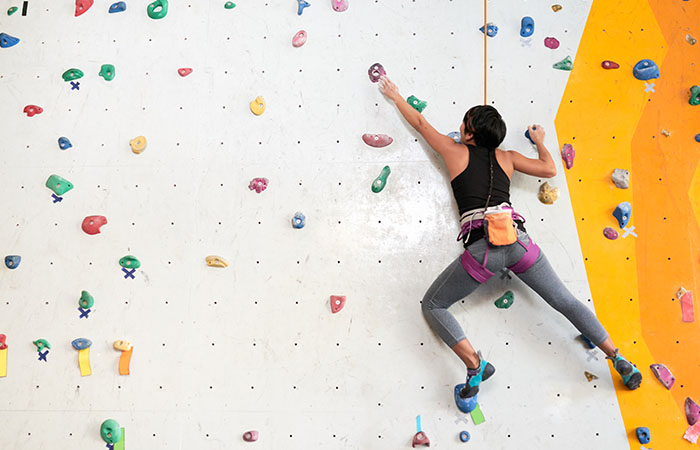The rising popularity of Ireland’s indoor climbing walls.
More and more people are literally climbing the walls every weekend!
The indoor climbing wall was once the sad afterthought in children’s play centres, lurking unused behind the slides and the coloured ball parks. It was the little used addition at the back of the odd gym with dust gathering on the coloured holds. Not anymore! Indoor Climbing Centres are the fastest growing fitness trend for this year. Once favoured by rock climbers for training and keeping fit in between their mountain adventures, they are now a regular part of many sport and fitness enthusiast’s daily regime’s. The hardened traditional climbers must now take their turn behind indoor climbers embracing this alternative to the gym. It is a fun way of getting fit. Many indoor wall climbers have no intention of ever climbing outdoors and view heading up the walls after a day at the office as a chance to destress and to get fit. The weather in Ireland also lends itself to indoor activities too.
Climbing Centres are exciting. They are basically a multi-coloured playground for adults! These adrenalin infused centres are also safe places to try an extreme sport without the ever present danger of falling to your death. (Always a plus!) Enthusiasts say it is a very social activity too, as conversation and interaction is more frequent than with your regular gym experience. Perhaps hanging off a wall by your fingertips is conducive to chatting… who knew?
Where is my nearest indoor climbing wall?
Dublin, Cork, Limerick, Waterford and Galway all boast excellent climbing walls centres. There are smaller walls in other locations and Google will help with finding your nearest indoor climbing experience. However, a full list of recommended climbing centres are available from the mountaineering Ireland website. www.moutaineeringireland.ie. These venues do regular route-setting on the walls, which means there is a constant flow of new challenges for climbers of all levels. Most of the centres have induction courses and training sessions for newbies and they can offer instruction and coaching to climbers of all abilities. Whether they want to improve their skills or personal performance, or just try something new.
Bouldering versus Lead Climbing?
Boulder climbing has overtaken lead climbing in popularity and is by far one of the most popular sports worldwide. Bouldering is solo climbing a rock or boulder some 3-5 meters high, with no harness or rope while lead climbing is climbing the holds, but with a harness and or ropes. Both are skilled activities which challenge the senses, the body and the mind. While you are not too far off the ground with bouldering, the adrenalin definitely pumps and the sense of achievement is huge. The Wall is Dublin’s best and biggest bouldering wall with over 1000 square metres of climbing surface and a wide range of angles and features. A good pair of climbing shoes makes a huge difference to the ease of traversing, while bouldering as grip is definitely a plus. The thrill of climbing without ropes in a safe environment is a real draw but for many, lead or rope climbing has a sufficient thrill factor and is just as challenging on the body and the mind.
What you Need?
Shorts and T-shirts are the usual choice of attire for indoor climbers. Common sense dictates that you shouldn’t have pieces of clothing flapping around as you traverse the boulders, but there are no hard and fast rules for what you should wear. A regular pair of sports shoes will do just fine for your first try at lead climbing and most centres will have specialist climbing shoes for hire, if you prefer. While climbing shoes are not essential, they will definitely enhance your climbing experience. Harnesses and ropes are always provided.
So, mostly you just need a go-to attitude and a sense of adventure!
Child’s Play
One of the joys of indoor climbing centres is that they cater for all ages, so they are perfect for family outings, birthday treats and rainy weekend adventures. The variety of routes on offer and the safety standards mean the young people can build confidence and core strength on suitable climbs. The brightly hued holds are colour coded for difficulty and the routes allow even small people to achieve dizzying heights in a safe way. Of course, there is always the embarrassment of having the kids out-climb you on the walls, but their happiness should be a comfort to your bruised ego.
Progressing to the rocks of the real world
Budding climbers often use indoor climbing walls to gain experience of working with ropes in order to progress on to outdoor rock faces. It’s a wonderful way to pick up many skills and gain experience. However, the transition to climbing outside is not just about fitness level and a working knowledge of the ropes. Searching for climbing holds in the gym is one thing, but facing that grey rock for the real-world equivalent that may be subtly blended into the rock face is another. For this reason, it is recommended that you join a club, or choose an experienced mentor, when you move from the climbing walls to the outside world. Ireland has many rock climbing and bouldering clubs, who welcome new members while sharing their experience and camaraderie on the cliffs and craggy rocks of Ireland.
The popularity of indoor climbing overtook its outdoor counterpart in the past year. This is only a taste of what is to come as more athletes get a taste for scrambling over boulders and shimmying down climbing walls! Sports climbing will make its debut in the 2020 Olympics in Japan and no doubt this will cause another surge of interest. So, this weekend if you feel like climbing the walls… you know exactly what to do.

